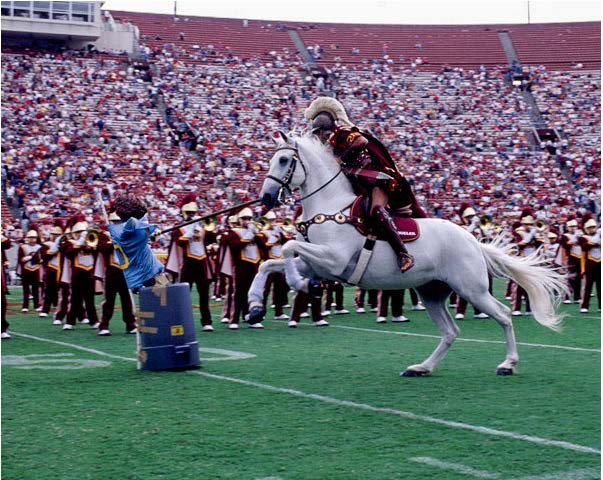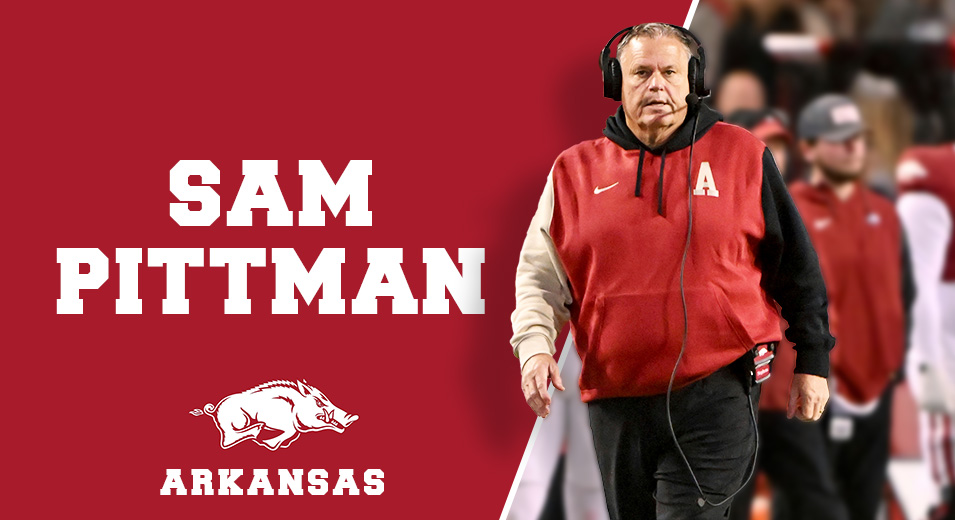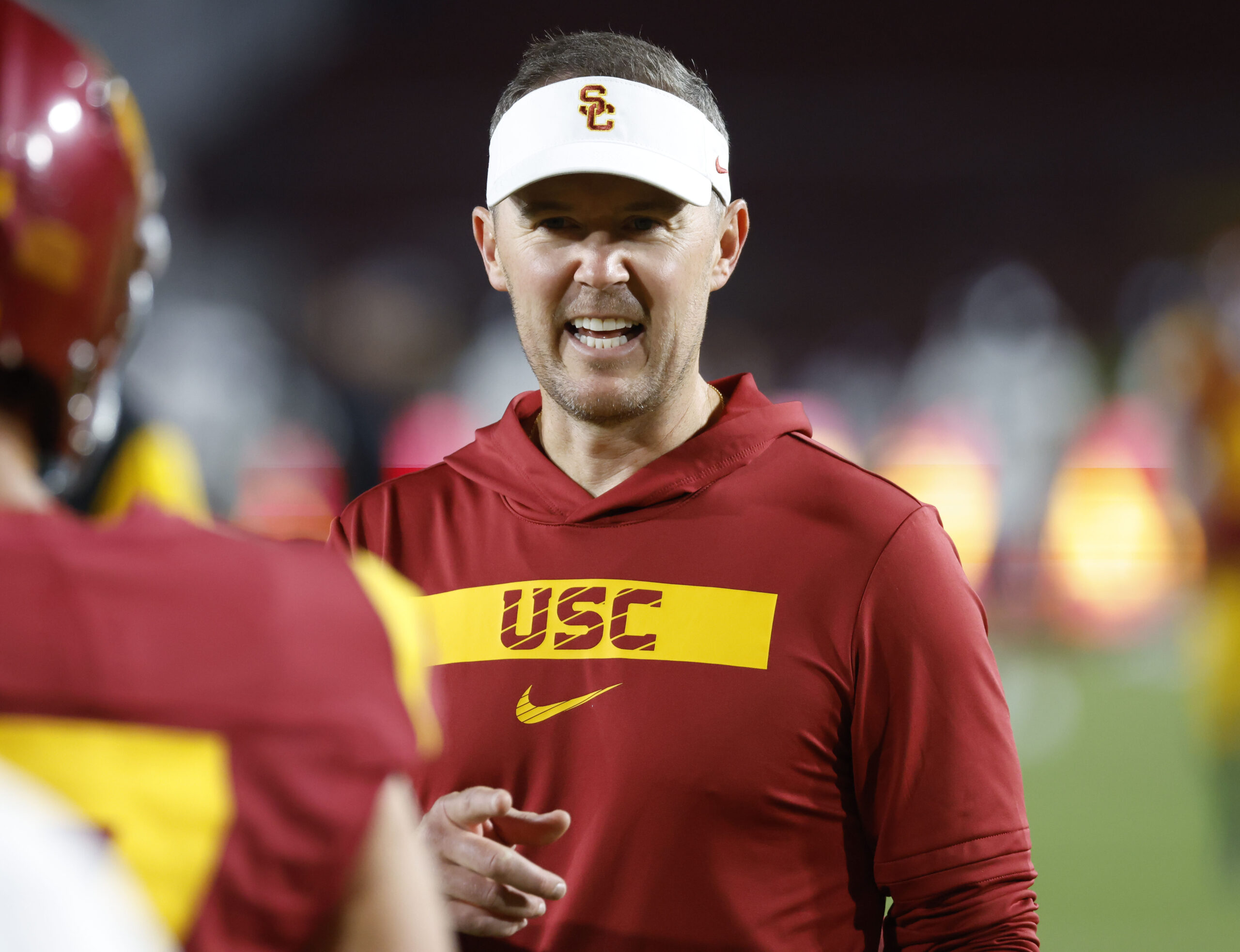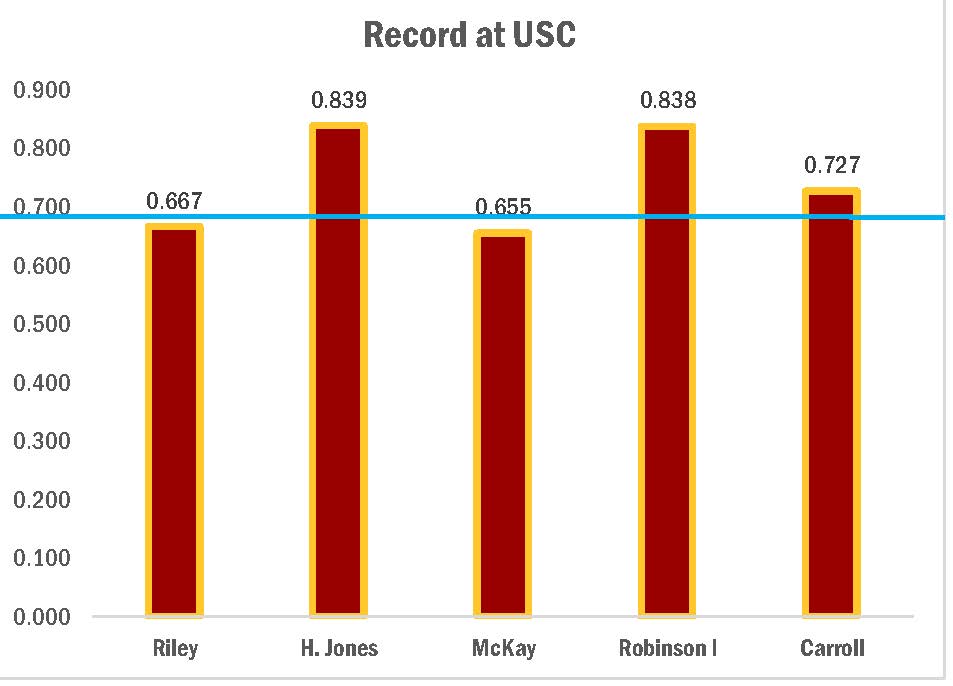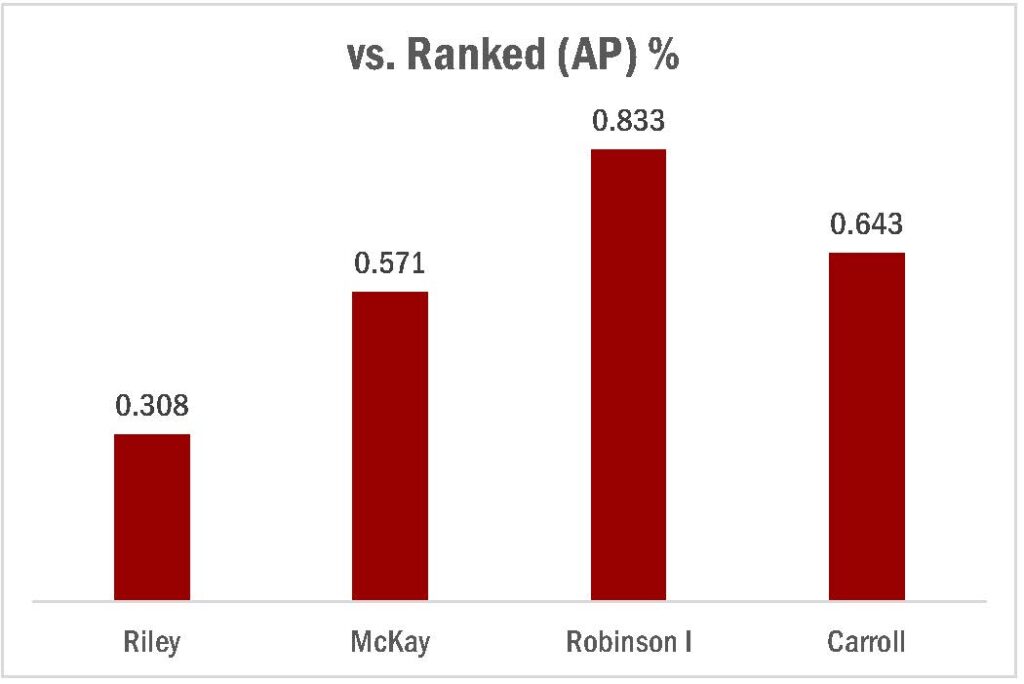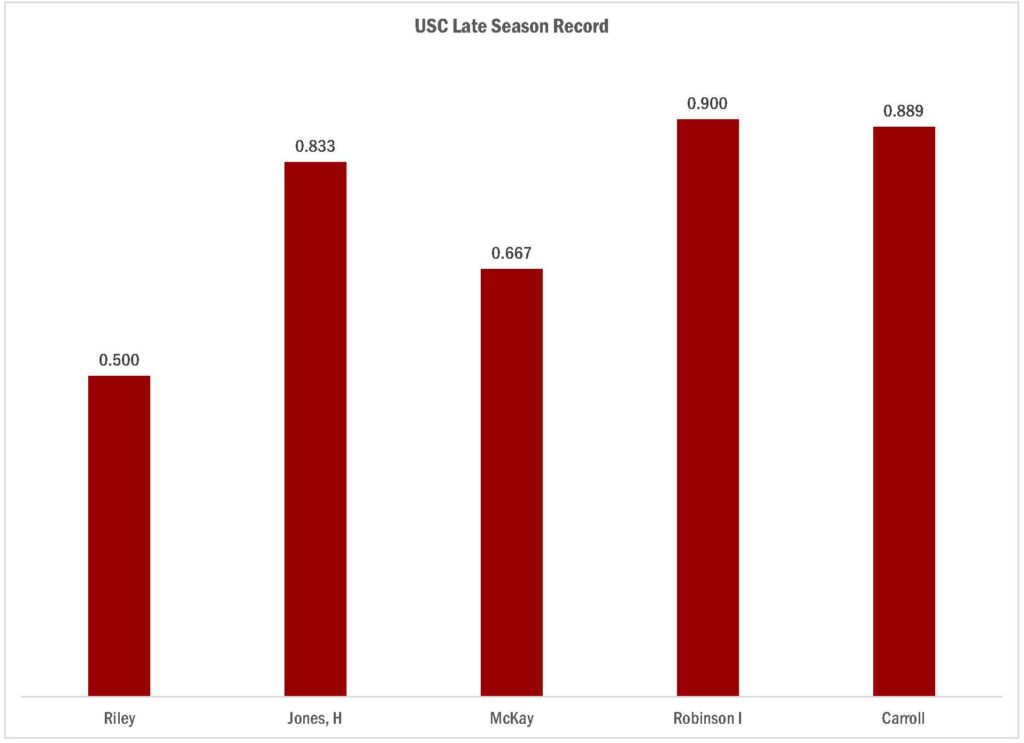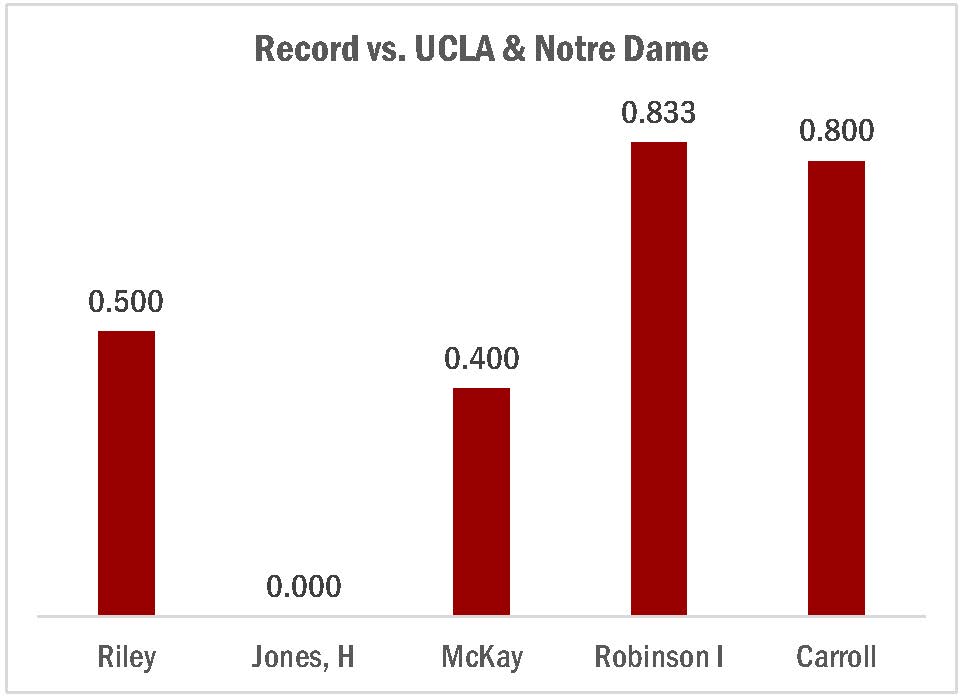Blog Article
USC’s $500 Million Gamble: Will 2025 Finally Deliver Championship Returns?
USC’s Lincoln Riley is running out of time.
After three seasons at USC, the once-celebrated coach who shocked college football by leaving Oklahoma now faces the most pressure of his career. His Trojans have regressed each year since an impressive 11-3 debut in 2022, stumbling to 8-5 in 2023 and a disappointing 7-6 in 2024. Meanwhile, USC has invested over $500 million in football infrastructure alone, making Riley’s tenure a fascinating case study in whether unlimited resources can overcome strategic missteps.
The 2025 season represents a crossroads. USC has made dramatic changes: hiring a $1 million general manager from Notre Dame, assembling the nation’s #1 recruiting class for 2026, and implementing the most comprehensive program overhaul since the Pete Carroll era. However, questions persist about whether these moves can address the fundamental issues that have plagued Riley’s tenure.
FanDuel has set USC’s win total at 7.5 games, exactly the same as the team achieved in 2024.
This conservative projection reflects both skepticism about the program’s immediate Big Ten contention and acknowledgment of its recent trajectory. Yet beneath these modest expectations lies a transformation that could finally break the cyclical pattern of hope and disappointment that has defined USC football for the better part of a decade.

The Notre Dame Heist That Changed Everything
Chad Bowden never planned to leave South Bend.
The Notre Dame general manager had just helped construct a roster that reached the national championship game. He was earning $300,000 annually in a role he’d built from the ground up, working alongside Coach Marcus Freeman in a program that was trending upward. Then USC called with an offer that tripled his salary and promised him “the greatest job in America.”
“USC, for me, it meant more to me,” Bowden explained during his introductory press conference. “When I was a kid, I watched Matt Leinart, Reggie Bush. That was my team. USC kind of held something in my heart.”
The hiring of Bowden for $1 million annually represents arguably the most impactful off-field acquisition in college football this offseason.
His track record speaks volumes:
- Four unanimously ranked Top 12 recruiting classes at Notre Dame (2022-2025)
- Named 2024 FootballScoop Player Personnel Director of the Year
- Helped Notre Dame reach #15 in transfer portal rankings in 2024
- Built championship-caliber rosters despite Notre Dame’s academic restrictions
The immediate impact has been staggering. USC currently holds the #1 ranking in the 2026 recruiting class according to multiple services, with 27 total commitments, including double-digit ESPN 300 prospects. This represents a dramatic philosophical shift from the transfer portal-heavy approach that defined Riley’s first three seasons.

The California-First Strategy
Bowden’s blueprint centers on a simple premise: stop letting elite California talent leave the state.
“I think the ’26 class is the best class that California has had in two decades,” Bowden told reporters. “If you look through it, and you really study what those classes look like, at least the top, probably 30, 40 players in the state.”
The numbers tell the story:
- USC’s 2026 class: 63% from California
- USC’s 2025 class: Just 23% from California
- Successful programs for comparison: Texas (60% in-state), Georgia (75% in-state)
“We’re going to major in high school recruiting and minor in the portal,” Bowden declared. “We’re not just recruiting the kids, we’re recruiting families…And we’re going to keep the best players in California home.”
This approach represents a philosophical shift from Riley’s first three seasons, during which USC signed 65 transfers in four years, resulting in short-term talent infusions but limiting long-term depth and cultural cohesion.
The organizational infrastructure supporting Bowden includes proven talent evaluators from Wisconsin and Illinois who helped build successful programs at their previous stops.
The D’Anton Lynn Defensive Revolution
USC’s defense was a national embarrassment in 2023.
The unit allowed 34.4 points per game, ranking among the worst in Power Five football. Opponents completed 64% of passes while averaging 432.8 total yards per game. The run defense surrendered 186.5 yards per game, making USC a target for every power-running offense on the schedule.
Then D’Anton Lynn arrived from UCLA with a simple message: “Don’t give anybody anything.”
The transformation under Lynn represents one of the most dramatic single-season defensive turnarounds in college football history.
The Numbers Don’t Lie
The statistical improvement from 2023 to 2024 was staggering:
Points Allowed Per Game:
- 2023: 34.4 (among worst in Power Five)
- 2024: 24.1 (middle of Big Ten pack)
- Improvement: Over 10 points per game
Total Defense:
- 2023: 432.8 yards per game (116th nationally)
- 2024: 365.7 yards per game (65th nationally)
- Improvement: 67 yards per game
Run Defense:
- 2023: 186.5 yards per game (116th nationally)
- 2024: 130.1 yards per game (43rd nationally)
- Improvement: 56 yards per game
Lynn, who reportedly earns approximately $2 million annually, making him the sixth-highest paid defensive coordinator nationally, was retained after Penn State attempted to poach him for their defensive coordinator opening.


Key Takeaways
Passing Defense:
While passing yards allowed per game improved under Lynn, the biggest leap was in run defense and overall efficiency.
Points Allowed:
D’Anton Lynn’s 2024 defense allowed over 10 fewer points per game than Grinch’s unit and was also a marked improvement over Orlando’s era.
Total Defense:
Under Lynn, USC allowed nearly 75 fewer yards per game than under Grinch, and almost 70 fewer than under Orlando.
Rushing Defense:
Lynn’s unit was especially improved against the run, cutting more than 50 yards per game off Grinch’s average and 30 off Orlando’s.
National Ranking:
USC’s national defensive rank improved dramatically under Lynn, jumping from 119th (Grinch) to 68th, the best since Orlando.
USC’s defense under D’Anton Lynn in 2024 showed significant statistical and ranking improvements compared to both the Todd Orlando and Alex Grinch eras. The Trojans went from one of the nation’s worst Power Four defenses to a respectable, mid-tier Big Ten unit—especially in points allowed and run defense—under Lynn’s leadership.
Cultural Transformation Beyond Statistics
The changes extended far beyond raw numbers.
Through two games early in 2024, USC’s defense was penalized just once—a dramatic improvement in discipline that reflected Lynn’s emphasis on fundamentals and accountability. Defensive end Jamil Muhammad captured the new mentality: “That’s one of coach Lynn’s biggest messages as well as the whole defensive staff, ‘Don’t give anybody anything. Whatever they get, that has to be them earning it.'”
“The tackling was getting better, it wasn’t perfect, there was some misses that we need to correct,” Lynn said after USC’s victory over LSU. “It’s something we have been emphasizing with all positional groups.”
Entering his second season, Lynn benefits from increased talent and depth that could elevate USC’s defense from respectable to elite.
The defensive line now features six players weighing over 300 pounds compared to just two in 2024. The secondary, bolstered by five-star early enrollee RJ Sermons and returning talent like safety Kamari Ramsey, represents a unit with significant upside.
The linebacker corps gained former NFL defensive coordinator Rob Ryan as position coach, bringing both credibility and scheme sophistication to a unit rebuilding after losing key contributors Easton Mascarenas-Arnold and Mason Cobb.
The Quarterback Gamble: Maiava’s Make-or-Break Moment
Jayden Maiava wasn’t supposed to be USC’s starting quarterback in 2024.
The UNLV transfer arrived as insurance behind Miller Moss, expected to learn the system and compete for future opportunities. Then USC stumbled to 4-5, Moss was benched, and Maiava suddenly found himself tasked with trying to salvage the season.
He delivered when it mattered most.
The Late-Season Surge
Maiava’s numbers in his final four starts tell a story of both promise and development:
- Record: 3-1 (including Las Vegas Bowl victory)
- Passing: 65% completion rate, 906 yards, 7 TDs, 3 INTs
- Rushing: 4 touchdowns
- Signature moment: Game-winning touchdown pass to Ja’Kobi Lane vs. UCLA
“I have a lot of confidence in Jayden,” Riley said during December’s early signing period. “He played well, led us to two big victories and I thought really put us in great position.”
The UCLA victory showcased Maiava’s dual-threat capability and clutch gene. Down late in the fourth quarter, he delivered a “Caleb Williams-esque play,” reversing field and slipping a tackle to find Lane in the back corner of the end zone for the game-winning score.
The Competition and Development
Maiava enters 2025 as the heavy favorite to start despite competition from five-star freshman Husan Longstreet.
Riley praised Maiava’s development during spring practice: “He’s not one that you worry about getting complacent or not wanting to work on the areas he knows he needs to attack and put in the necessary time and effort. For him, it’s sometimes more like don’t be so hard on yourself.”
The quarterback room represents both USC’s biggest question mark and greatest opportunity for transformation.
Maiava’s mobility adds a dimension that was missing during the Moss era. His ability to extend plays and create with his legs provides Riley with additional options in an offense that struggled with balance throughout the 2024 season.
Riley’s Strategic Crossroads: Pass-Happy Tendencies vs. Balanced Success
Lincoln Riley built his reputation on offensive innovation and balance.
His Oklahoma teams consistently ranked among the nation’s leaders in both passing and rushing efficiency. The counter-run scheme was a staple of those Sooner offenses, providing the foundation for explosive passing games by establishing physical dominance and maintaining offensive balance.
Then he arrived at USC, and something changed.
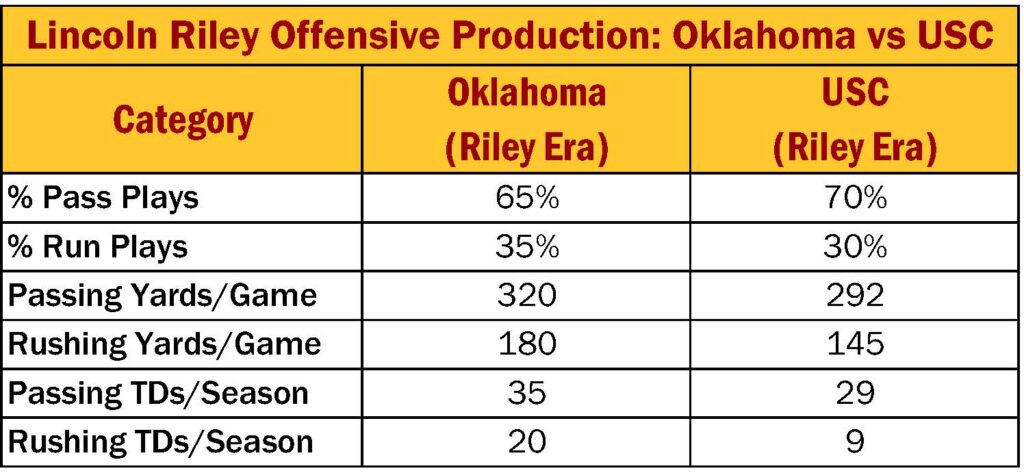
The Troubling Pass-First Trend
Riley’s recent tendencies toward pass-heavy play-calling represent a concerning departure from his most successful approach:
- Called 50+ passes in three separate games during 2024 (never did this at Oklahoma)
- USC went 0-3 in games where quarterbacks threw 50+ times
- Against Michigan: 51 passes vs. 21 rushes
- Against Washington: 29 passes vs. 8 runs in first half alone
This trend contradicts Riley’s earlier success at Oklahoma, where balanced attacks featured elite quarterback play supported by dominant rushing games. The departure of proven runners and Riley’s apparent lack of trust in USC’s ground game led to a one-dimensional approach, which Big Ten defenses effectively exploited.
“I don’t think there’s like one area of our program where like we’re so far away from being like great or championship caliber,” Riley said in a recent interview. “What I just see is like every part of it just got to continue to get a little bit better.”
This assessment reflects confidence but also acknowledgment that USC’s issues span multiple areas rather than requiring wholesale changes.
The hiring of new position coaches—including tight ends coach Chad Savage from Colorado State and offensive line coach Zach Hanson—suggests efforts to address scheme and development issues. Whether these changes can restore the balanced, explosive offense that defined Riley’s reputation remains a central question for 2025.
The Offensive Line Vulnerability That Could Derail Everything
USC’s offensive line represents a ticking time bomb.
While the projected starting five appears capable, featuring returning starters Elijah Paige and Alani Noa alongside transfers J’Onre Reed (Syracuse) and DJ Wingfield (Purdue), depth remains a significant concern. Tobias Raymond emerged as a reliable option at right tackle, but the quality of backup linemen remains questionable.
If injuries strike the starting unit, USC may lack the depth necessary to maintain Big Ten-level protection and run blocking.
This vulnerability reflects years of under-recruitment and development in the trenches, an issue that Bowden’s recruiting emphasis aims to address but won’t fully resolve until future recruiting classes arrive on campus.
The receiving corps provides reason for optimism despite portal losses:
- Ja’Kobi Lane returns after catching 48 passes for 721 yards and 7 TDs from Maiava
- Makai Lemon provides veteran leadership and reliable production
- Depth chart features talented underclassmen ready for expanded roles
Lane’s spectacular spring practice performances, including a viral one-handed catch, suggest continued growth. “The spectacular plays that he makes on the field it’s no surprise,” Maiava said. “That’s who Ja’Kobi is, he’s going to go up and make those plays every time the ball comes his way.”
The Big Ten Gauntlet: Schedule Reality Check
USC’s 2025 schedule tells two different stories.
The non-conference portion opens with games against Missouri State (August 30) and Georgia Southern (September 6), which should provide early momentum and confidence-building opportunities. These matchups provide Riley and his staff with opportunities to build chemistry and establish an offensive rhythm before facing conference competition.

Then the Big Ten reality arrives.
The Crucial Crossroads Games
USC faces several defining matchups that will likely determine the season’s trajectory:
At Home:
- Michigan (rebuilding under new leadership after coaching change)
- UCLA (crosstown rivalry, winnable game)
- Iowa (low-scoring, defensive battle)
On The Road:
- Oregon at Autzen Stadium (hostile environment, championship-caliber opponent)
- Notre Dame in South Bend (Riley is 1-2 vs. Fighting Irish)
- Nebraska, Purdue, Illinois (potential trap games testing depth and focus)
The schedule’s structure reflects both opportunity and peril. USC avoids Ohio State and Penn State from the conference’s upper tier, creating a more manageable path to eight or nine wins. However, the program’s recent struggles in road conference games—going 0-3 outside California in Big Ten play during the 2024 season—highlight the challenge of competing consistently in a league that demands physical and mental toughness week after week.
Riley acknowledged the unique nature of USC’s Big Ten debut during a recent ESPN appearance: “We played in just an amazing number of one-score games, and it was kind of down to the last play of the games. I could probably coach 50 years and not have another season that that kind of winds up like that.”
Breaking the Trojan Emotional Rollercoaster
USC fans know this cycle by heart.
August arrives with renewed optimism fueled by recruiting victories and coaching changes. Early-season momentum builds against overmatched opponents, creating dreams of playoff contention. Then comes the devastating loss to elite competition, followed by bargaining for “statement wins” and eventual disappointment when the season slips away.
The 2025 season threatens to repeat this familiar pattern.
The Structural Changes That Could Break The Cycle
Yet there are legitimate reasons to believe this year might be different:
Organizational Infrastructure:
- Professional front office led by a proven GM
- Enhanced recruiting staff and evaluation systems
- Modern NIL and roster management approach
Defensive Foundation:
- Proven coordinator in Lynn with a track record of improvement
- Significantly upgraded talent and depth
- Cultural emphasis on physicality and accountability
Recruiting Momentum:
- #1 ranked 2026 class with a focus on California dominance
- Shift from portal dependence to sustainable high school recruiting
- Elite prospects at positions of need (offensive line, secondary)
The challenge lies in translating these improvements into victories in November and December, when championships are decided and fan patience is at its greatest test. USC’s recent history of close losses (five games by a combined 16 points in 2024) suggests the program is closer to breakthrough success than its record indicates.
Converting moral victories into actual wins requires the mental toughness and depth that have been conspicuously absent in recent seasons.
The $500 Million Question: Investment vs. Returns
USC’s financial commitment to football excellence is staggering.
Beyond Riley’s $11.5 million annual compensation and Bowden’s $1 million salary, the program is constructing the $225 million Bloom Football Performance Center, while also completing a $315 million renovation of the Coliseum. This represents over half a billion dollars invested in football infrastructure alone.
The return on investment remains questionable.
Riley’s 26-14 record at USC, coupled with regression in each of his seasons since his 2022 debut, has generated skepticism about whether the financial commitment aligns with competitive results. The massive buyout—estimated between $80-90 million—provides Riley job security while intensifying pressure for tangible improvement.
Athletic Director Jen Cohen expressed confidence in her embattled coach: “Lincoln has the experience, right? He’s built and led championship teams before. So my focus with him is just investing and giving him, and not just him, but his entire coaching staff, his support staff that he has around him, every resource possible to get to the next level.”
2025 Projections: Three Realistic Scenarios
Best-Case Scenario: The Breakthrough (9-3)
If the defensive improvements continue, the offensive line stays healthy, and Maiava takes a significant step forward, USC could surprise skeptics with nine wins and legitimate bowl game aspirations.
This would require:
- Victories in several “coin flip” games against middle-tier Big Ten opponents
- Splitting marquee matchups against Michigan, Oregon, and Notre Dame
- Sustained health along the offensive line
- Maiava’s development into a consistent dual-threat quarterback
Most Likely Scenario: Modest Progress (7-5 to 8-4)
The 7.5-win projection reflects realistic expectations for a team still adapting to Big Ten physicality while integrating new personnel.
Key factors:
- Continued defensive improvement under Lynn
- Offensive line depth tested, but surviving
- Maiava is providing competent but inconsistent quarterback play
- Home-field advantage is proving decisive in close games
This range would represent modest progress but likely wouldn’t satisfy boosters or fans expecting more dramatic improvement given the program’s investment level.
Worst-Case Scenario: Continued Regression (6-6 or worse)
Injuries to the thin offensive line, continued defensive inconsistency, or struggles by the quarterback could leave USC fighting for bowl eligibility again.
This outcome would:
- Almost certainly intensify pressure on Riley
- Potentially accelerate discussions about program direction
- Raise serious questions about the massive financial investment
The 2026 Vision: Championship Foundation or Recruiting Mirage?
The actual test of Bowden’s impact may not come until 2026.
USC’s current #1 recruiting class ranking includes elite prospects at positions of need, particularly along both lines of scrimmage and in the secondary. However, the program’s recent history of late decommitments—losing four five-star prospects in the final weeks of the 2025 cycle—serves as a cautionary reminder not to count commitments before signing day.
“I think the ’26 class is the best class that California has had in two decades,” Bowden told reporters, emphasizing the talent pool available to USC in their backyard.
The 2026 class features impact prospects who could transform USC’s championship potential:
- Five-star offensive tackle Keenyi Pepe (IMG Academy)
- Five-star cornerback Elbert Hill (Ohio)
- Multiple blue-chip linemen and defensive backs
- Elite skill position talent from California
Suppose this class holds together and develops as projected. In that case, USC will be positioned as a legitimate Big Ten and College Football Playoff contender for the first time since the Pete Carroll era.
The Verdict: Crossroads Season Arrives
The 2025 USC football season arrives at a unique crossroads.
The structural improvements—from Bowden’s hiring to enhanced recruiting infrastructure to defensive personnel upgrades—provide legitimate reasons for optimism that extend beyond the usual offseason hope. The shift toward sustainable roster construction, emphasis on California recruiting dominance, and cultural changes under Lynn represent the most comprehensive program overhaul in years.
Yet the challenges remain formidable.
An unforgiving Big Ten schedule tests depth at crucial positions where USC remains vulnerable. The weight of massive expectations, fueled by unprecedented financial investment, creates pressure that has derailed previous seasons. The familiar cycle of August optimism and midseason disappointment lurks as a possibility that could define Riley’s legacy.
As Cohen noted earlier about Riley’s proven track record, the 2025 season will ultimately determine whether her faith in the embattled coach is justified. With unprecedented resources, structural improvements, and talent upgrades in place, this represents Riley’s best—and perhaps final—opportunity to prove that USC’s $500 million investment will pay championship dividends.
For a fan base accustomed to the emotional rollercoaster of unfulfilled promises, 2025 offers both familiar risks and unprecedented reasons for hope. The infrastructure for sustained success is being built.
Whether it translates to victories in November and December—when championships are decided and legacies are forged—remains college football’s most compelling storyline as USC attempts to reclaim its place among the sport’s elite.
The Next Billion Dollar Game
College football isn’t just a sport anymore—it’s a high-stakes market where information asymmetry separates winners from losers. While the average fan sees only what happens between the sidelines, real insiders trade on the hidden dynamics reshaping programs from the inside out.
Our team has embedded with the power brokers who run this game. From the coaching carousel to NIL deals to transfer portal strategies, we’ve mapped the entire ecosystem with the kind of obsessive detail that would make a hedge fund analyst blush.
Why subscribe? Because in markets this inefficient, information creates alpha. Our subscribers knew which coaches were dead men walking months before the mainstream media caught on. They understood which programs were quietly transforming their recruiting apparatuses while competitors slept.
The smart money is already positioning for 2025. Are you?
Click below—it’s free—and join the small group of people who understand the real value of college football’s new economy.
